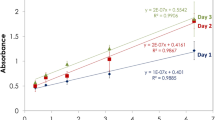Abstract
Scanning electron microscopy (SEM) studies were performed on freshly prepared and freeze-dried Tice™-substrainMycobacterium bovis BCG vaccine as well as Tice BCG grown on Middlebrook 7H10 agar. Intact colonies of the Tice and Glaxo BCG substrains growing on agar were also examined. The presence of developmental stages of the mycobacterial life cycle previously reported in the literature was confirmed in actively growing BCG and in commercial vaccine preparations. The pleomorphic forms consisted of various size coccal and bacillary cells. Propagation appeared to occur by fission of both forms to produce aggregate bodies and by a coccal-bacillary cycle. Filterable (30–200 nm) granular cocci and coccal microcolonies were also observed in commercially prepared BCG vaccines. The implications of pleomorphism on the biologic activities of various BCG vaccines are discussed.
Similar content being viewed by others
Literature Cited
Csillag A (1964) The mycococcus form of mycobacteria. J Gen Microbiol 34:341–352
Devadoss P, Klegerman ME, Groves MJ (1991) Surface morphology ofMycobacterium bovis BCG: relation to mechanisms of cellular aggregation. Microbios 65:111–125
Kölbel HK (1984) Electron microscopy. In: Kubica GP, Wayne LG (eds) The mycobacteria: a sourcebook, part A. New York: Marcel Dekker, pp 249–300
Mattman LH (1970) Cell wall deficient forms of mycobacteria. Ann NY Acad Sci 174:852–861
Mattman LH (1974) Cell wall deficient forms. Cleveland, OH: CRC Press, pp 171–181
Ibid.,, pp 327–334
Ibid.,, pp 335–341
Merckx JJ, Brown AL Jr, Karlson AG (1964) Morphology of two strains of mycobacteria grown in artificial media as studied with the electron microscope. Acta Tuberc Scan 45:204–220
Rosenthal SR (1937) Studies with BCG IV. The focal and the general tissue response and the humoral response; the intradermal route. Am J Dis Child 54:296–321
Rosenthal SR (1980) BCG vaccine: tuberculosis-cancer. Littleton, MA: PSG Publ Co, pp 83–84
Rosenthal SR, Heagan B (1955) Studies of the life cycle of the tubercle bacillus (BCG). Ann Inst Pasteur 88:479–487
Stewart-Tull DES (1965) Occurrence of dimorphic forms ofMycobacterium phlei. Nature 208:603–605
Udou T, Ogawa M, Mizuguchi Y (1982) Spheroplast formation ofMycobacterium smegmatis and morphological aspects of their reversion to the bacillary form. J Bacteriol 151:1035–1039
Youmans GL, Youmans AS (1971) Relative effectiveness of living and non-living vaccines. In: Immunization in tuberculosis. Washington, DC: DHEW Publ No (NIH) 72–68, pp 219–236
Author information
Authors and Affiliations
Rights and permissions
About this article
Cite this article
Devadoss, P.O., Klegerman, M.E. & Groves, M.J. A scanning electron microscope study of mycobacterial developmental stages in commercial BCG vaccines. Current Microbiology 22, 247–252 (1991). https://doi.org/10.1007/BF02092317
Issue Date:
DOI: https://doi.org/10.1007/BF02092317




